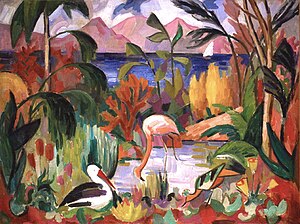Paysage coloré aux oiseaux aquatiques
| Paysage coloré aux oiseaux aquatiques | |
|---|---|
 |
|
| Artist | Jean Metzinger |
| Year | c.1907 |
| Medium | Oil on canvas |
| Dimensions | 75.5 cm × 101 cm (29.7 in × 39.8 in) |
| Location | Musée d’Art Moderne de la Ville de Paris |
Paysage coloré aux oiseaux aquatiques (Colored Landscape with Aquatic Birds) is an oil painting created circa 1907 by the French artist and theorist Jean Metzinger. Paysage coloré aux oiseaux aquatiques is a Proto-Cubist work executed in a Post-Divisionist style with a unique Fauve-like palette. Metzinger's broad omnidirectional brushstrokes in the treatment of surfaces render homage to Paul Cézanne, while the luscious subtropical imagery in the painting are an homage to Paul Gauguin and Metzinger's friend Henri Rousseau.
Paysage coloré aux oiseaux aquatiques is located at the Musée d’Art Moderne de la Ville de Paris.
Paysage coloré aux oiseaux aquatiques is an oil painting on canvas in a horizontal format with dimensions 75.5 x 101 cm (29.7 by 39.8 in). The work represents three aquatic birds in an ambrosial Mediterranean landscape with semi-tropical vegetation, trees, a body of water, mountains and a sailboat in the background. The free and expressive brushstrokes of Paysage coloré aux oiseaux aquatiques—as in Les Ibis and Le Flamant rose et le voilier of the same period—represent a loosening of the mosaic-like Divisionist technique that characterized Metzinger's work from 1905 to early 1907.
By 1907 a select group of avant-garde artists in Paris were reevaluating their own work in relation to that of Paul Cézanne. A retrospective of Cézanne's paintings had been held at the Salon d'Automne of 1904. Current works were displayed at the 1905 and 1906 Salon d'Automne, followed by two commemorative retrospectives after his death in 1907. Metzinger's interest in the work of Cézanne suggests a means by which he made the transformation from Divisionism to Cubism.
The lattices of squares or 'cubes' of paint employed throughout his Divisionist period have not been entirely abandoned, but pushed to another extreme. Where before brushstrokes had become increasingly larger and organized into groups of color, now they were larger still and elongated, seemingly blended together directly on the canvas (rather than on a palette). The treatment of color and composition is globally free, loose, expressive, and thus dynamic. There are no inert tones. Colors have retained their brilliance. As before, contrasting hues are placed side by side—resulting in rhythmic and optic vibrational effects.
...
Wikipedia
